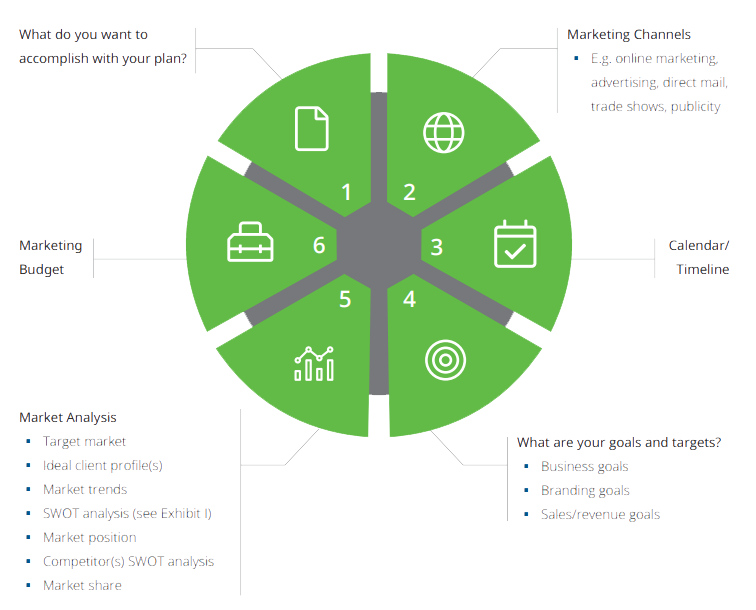How to Build a Small Business Marketing Strategy (Guide)

A strong brand communicates who you are and the problems you solve, while marketing conveys your brand message and engages your target audience, helping you acquire new clients. Without a clearly defined and visible brand, you risk missing out on potential opportunities.
GATE
5 Ways to Build Your Brand
Branding is more important in today’s business world than ever before. If you don’t develop a clear and distinct brand, you may get lost in a sea of competitors. Branding will set you apart, help you communicate who you truly are, and can become the cornerstone of how you and your independent business communicate to customers.
So, take the time to build your brand and be authentic in how you communicate it. Then you’ll be well on your way to demonstrating your leadership and expertise in your field.
Here are five ways to build your brand successfully:
- Define your unique selling point
A successful personal brand will define what sets you apart and makes you unique. Take time to understand what differentiates your business and write a personal branding statement that defines who you are, what you do, and who you serve. Let this be your guide to use when describing yourself and your business. - Establish your expertise
Position yourself as an expert or thought leader in your industry. Use your personal website to clearly illustrate what sets you apart from others in your field. You may wish to create a blog and showcase your expertise by offering helpful advice and solutions. Leverage social media channels such as LinkedIn and X (Twitter) to share your knowledge and connect with other independent professionals in your field. Network with like-minded entrepreneurs, consider speaking at events, and offer online or offline workshops. - Be consistent
In everything you do, develop and maintain your brand. Whether online or offline, maintaining consistency in your message is the secret ingredient to personal and business branding success. Remember, a strong and cohesive brand not only attracts ideal clients but also fosters trust and loyalty over time. - Be personal
It’s simple: People buy from people. Engage with your market on a personal level by sharing elements of your own life. Remember to show your human side and personalize your brand to build and maintain trust. However, there are rules to follow when mixing personal with professional. Here’s a good rule of thumb: Anything personal you decide to share should elicit trust and respect from your audience. - Monitor and refine
As you grow your business, you may need to update or refresh your personal brand to reflect these changes. It’s also important to perform regular monitoring of your brand online for any negative sentiment.
A brand is a customer experience represented by a collection of images and ideas; often, it refers to a symbol such as a name, logo, slogan, and design scheme. Brand recognition and other reactions are created by the accumulation of experiences with the specific product or service, both directly relating to its use, and through the influence of advertising, design, and media commentary. – American Marketing Association
How to Define Your Market
Identifying your target audience will help you to focus your marketing and messaging efforts. Once you define your market, you can then determine where this group spends their time and how they prefer to communicate.
For example, knowing where your audience is represented on social media, what type of trade publications they read, and whether they are likely to attend industry conventions can help you create a more targeted message.
Narrow your scope
Before launching your marketing effort, it’s essential to clearly define your target market and ideal client to give your marketing plan focus. With a specific audience in mind, you will be able to effectively design a marketing plan to reach them. While it may seem counterintuitive, marketing to a smaller, clearly defined group often yields better results than casting a wide net. A mass marketing approach can be costly and highly inefficient for independents. Additionally, it’s much more fulfilling to work with clients who not only want what you have to offer but also provide an environment where you can do your best work.
Create your ideal client profile
Creating a profile of your ideal client can provide a foundation for your marketing efforts. Think of this profile as a roadmap to your ideal client that enables you to recognize financial and non-financial benefits. An ideal client profile will help you identify the clients you want to target and eliminate those who are not a match. This can be beneficial as it enables you to dedicate your time and resources to the highest-value clients.
Ideal clients will align not only with your service offerings but also with your business style and goals. A great way to start developing your ideal client profile is to look at your past or existing clients. Are there clients you enjoyed working with more than others? What qualities made these partnerships so successful? What common characteristics do these clients share?
As you work through this process, you may discover that your ideal clients have similar organizational structures, company sizes, or cultures.
10 questions to answer:
- Gender, age
- Location (local, regional, national, global)
- Education level
- What is the biggest problem they face?
- What do they fear?
- What problem can you solve for them?
- What is their motivation for working with you?
- Are they willing to pay your fees?
- What publications do they read (online and offline)?
- Do they belong to any associations or professional groups?
You may find that you have more than one ideal client. Many experts suggest giving your profiles a persona to help you be more detailed. For example, Nancy Nonprofit is a nonprofit CEO in her 40s, married with two teenage children. Nancy is afraid the economy will have a detrimental impact on her fundraising efforts. She strives to build sustainable communities that not only donate time and money but will also spread the word about her company.
Going beyond basic demographic information and getting down to your ideal client’s fears, motivations, wants, and needs will empower you to create a targeted marketing plan.
Define your target market
Once you’ve identified your target market, consider the following questions:
- Is the market big enough?
While targeting a small market might seem appealing, a market that’s too small may not sustain future opportunities. Ensure that your market criteria aren’t so narrow that you won’t have room for growth. To understand how the size of a market can impact your marketing efforts, use a keyword search tool. Choose a broad term like “real estate” and then apply filters that narrow it down to a more realistic market size. - Will your identified market see a need for your services?
Many people live every day with a problem or pain point that can actually be solved. Your service may solve a very real problem—but remember that your market also has to see the need for it. - Do I have access to my market?
To deliver a message, you have to be able to reach your market. Highly specialized markets may prove inaccessible to reach and may require you to broaden your audience. - Can my market afford my offering?
Your audience may fit all the criteria, but they must also have the budget—and see the value—of engaging with you and buying your services.
Taking the time to develop an ideal client profile will allow you to maximize your opportunities and minimize your risks.
How to Create a Marketing Strategy
A marketing plan gives you an opportunity to take a close look at your business as a whole and align your business and marketing objectives. It also helps you to efficiently allocate your resources and provides a method to measure progress and outcomes.
Before you start drafting your marketing plan, you first need a clear marketing strategy in place. Your marketing strategy should always align with your overall business goals, whether that’s growing revenue, expanding your service offerings, or entering a new geographic area. In summary, your strategy outlines what needs to be accomplished, and your marketing plan serves as the blueprint for how you will achieve those goals.
8 questions to help you create your marketing strategy
- What are your overall business goals? You may consider breaking these down into 3 months, 6 months, 12 months, and long-term.
- What is your brand message? Who are you and what makes you unique?
- Who is your target market?
- What problems do you solve for your clients?
- What do clients gain from engaging your services? Remember to focus on benefits to the client rather than features.
- What is your competitive positioning? Examples may include ease of use, value, or guarantees.
- How are you going to reach your market and with what messaging?
- What price will you charge? Define price points for each market segment.
Your marketing strategy should be broken down into multiple levels: long-term, short-term, and immediate needs for your business. Try starting with your long-term goals and work backwards from there. Often, it’s more effective to first visualize the overall goal and then outline the steps to achieve it.
Creating a marketing budget
Plan a budget so that you know what you are spending and how that money will be allocated. One way to determine your budget is to look at your competitors and what they are spending. These competitors should be roughly the same size and offer the same product or services so that you can get an accurate analysis of what your company should be spending.
Many businesses allocate a percentage of their annual revenue to marketing. As a general rule, the Small Business Administration (SBA) advises that if your revenues are less than $5 million, then you should allocate 7% to 8% of your revenues to marketing. This assumes that after you have covered all your business expenses, including marketing, your profit margins are in the range of 10% to 12%.
Tools for measuring results
Once you’ve established your budget for marketing, you want to allocate it appropriately and track your return on investment (ROI). This process involves prioritizing your marketing efforts and spending on strategies where you will get the highest return.
To ensure that your budget is being used correctly, set benchmarks to measure your success. How you quantify your marketing goals will largely depend on what you choose to measure. For example, if your goal is to drive more traffic to your website, you can use Google Analytics to measure progress and outcomes. If your goal is to increase sales by 30%, you will want to measure that number so you can track your progress.
Your marketing plan should include measurable goals and a system for tracking progress. The following are a few tools can help you measure the effectiveness of your campaigns:
1. Manage a database
Collect information from a database to help track and measure campaigns. For example, if you use a Customer Relationship Management (CRM) system, you can track leads against a specific campaign (online or offline), sign-ups, and sales. You can also subscribe to databases specific to the kinds of campaigns you are running. If PR is a large part of your marketing mix, a media database will allow you to monitor media mentions and pick-ups of press releases. Meanwhile, social media databases can help you measure your social media marketing.
2. Use campaign-specific tools
Today, big data is accessible to businesses of any size. If you run an ad on a social platform, you can measure the effectiveness of your message, image, and targeting using the tools the platform provides or a third party yet cost-effective analytics program like Google Analytics.
3. Ask customers
Don’t be afraid to ask prospective customers how they found you. This should be a routine part of your business and can help you fine-tune your marketing efforts. For instance, a customer may call you after opting in to your online sign-up form, but they may have first learned of you from a word-of-mouth referral.
Depending on your objective, you can measure the ROI of your marketing investment using one of three methods:
- Cost per Sale = Amount spent for event or campaign / number of sales
- Cost per Qualified Lead = Amount spent for event or campaign / number of qualified leads
- Cost per Visitor = Amount spent for event or campaign / number of visitors or responders
Once you decide which result you want to measure and you have the costs incurred for your campaign, calculating these methods is fairly simple.
Your marketing strategy should always align with your overall business goals, whether that’s growing revenue, expanding your service offerings, or entering a new geographic area.
How to Develop a Marketing Plan
At this point, you’ve done much of the research and planning that will help you complete your marketing plan. It doesn’t need to be lengthy; it should be a practical tool that you can use, review, and refine to stay on track toward achieving your goals. Use the following outline to help you draft your plan.
MARKETING PLAN OUTLINE
The following are a few tools that you can use to measure the effectiveness of your campaigns:

How to Use Marketing Channels
There are many ways to market your business today, including:
- Direct marketing:
Marketing directly to your target audience, such as direct sales letters, email marketing, or sales cold calls. - Inbound marketing:
Marketing to help customers find you more easily. For example, you may create content that attracts your target market or optimize your website for search engines. - Social media marketing:
Use social media sites to engage your target audience and/or to drive traffic to your website. - Referral marketing:
Promotion through your existing network, including colleagues and current and past clients. - Word of mouth marketing:
Satisfied customers spread the word about your business verbally or in writing, such as on Yelp or Google reviews, or via social media channels.
Your target market is the best way to determine how you will spend your marketing dollars along with the marketing channels you’ll use. The key is to consider who you are trying to reach and what media they are most likely to use.
For example, if your target audience reads print trade journals, consider pitching articles to target publications. This is a lower cost option than advertising and a much more effective way to demonstrate your business expertise. If your audience is active on Facebook, create a page for your business and utilize ads to grow your audience.
9 Simple Ways to Market Your Business
Here are nine simple ways to market your business. Each of these methods has their own benefits, so consider using several or all of them.
- Create your own blog
Create a content calendar and stick to a publishing schedule. Post regularly to maximize search opportunities but keep in mind that consistency is even more important than quantity. - Write guest posts and articles
Offer content to other publications to market to your business. Make a list of publications that share your target audience and pitch relevant articles or posts. - Write a column for your local newspaper
This could be a how-to column or a Q&A in your area of expertise. - Run a Google AdWords campaign
Develop a master list of keywords and phrases for your business using Google’s Keyword Planner. Then, design a specific landing page for your campaign. This page may be a list of FAQs, tips, or other information specific to the audience you are targeting. - Use LinkedIn
You may already be using LinkedIn for your personal brand, but there are many other features you can use to market your business. Consider the following: Start out by creating a company page and use the profile section to tell your story. Regularly post relevant updates to keep a steady stream of fresh content. Reach out to current and past clients and ask them to recommend your business. Join or create a LinkedIn group to connect with prospective clients. - Contact former clients
Referrals should be a part of every company’s marketing plan. Create a referral program and promote it to your past and existing clients. Consider developing an automated system to nurture your referral network for a steady flow of new business. - Tap into media outlets
Press releases can be an excellent marketing tool, as they have the potential to reach thousands of prospective clients. To maximize your visibility, include multimedia elements such as photos or videos. You might decide to create a press release calendar for the year, so you have a consistent schedule, whether you choose to publish a release quarterly or monthly, for example - Create your own YouTube channel
There are many ways to use video to market your business. Consider offering advice, answering common questions in your industry, or interviewing other experts. You can share these videos on platforms like YouTube to reach a wider audience and enhance your online presence. - Use email marketing
Email marketing is a great tool to create or advance relationships with your target audience. If you intend on reaching prospective and current clients via email, you will need to utilize an email service such as Constant Contact, Active Campaign, or MailChimp. To comply with legal requirements, people must give you permission to market by opting in to receive mail.
Final Thoughts
In all your marketing efforts, remember that marketing is about building relationships, not just closing a deal. Encourage your prospective clients to make a small commitment, such as opting in to your mailing list or liking your Facebook page. This will enable you to build the relationship and lead them to the next step—perhaps a phone consultation or product demo. The key is to build trust as you guide them towards your company to solve their problem.
Exhibit 1: SWOT Analysis
The SWOT Analysis framework is used to evaluate the Strengths, Weaknesses, Opportunities, and Threats of a venture or project.
STRENGTHS: Characteristics of the business or project team that give it an advantage over others
WEAKNESSES (or Limitations): Characteristics that place the team at a disadvantage relative to others.
OPPORTUNITIES: External chances to improve performance (e.g. make greater profits) in the environment.
THREATS: External elements in the environment that could cause trouble for the business or project.
A SWOT analysis is a versatile tool that can be used to evaluate many things, including:
- A company (position, commercial viability, etc.)
- A product or brand
- A new business idea
- A strategic option, such as entering a new market or launching a new product
- An opportunity for partnership or acquisition
- Project planning and management
- Personal planning (starting a business, investments, life change, etc.)

In this guide
Subscribe to the Insights blog to get weekly insights on the next way of working

Join our marketplace to search for consulting projects with top companies
Related posts
Learn more about MBO
Learn how to start, run and grow your business with expert insights from MBO Partners
Learn how to find, manage and retain top independent contractors for your projects.
MBO Partners publishes influential reports, cited by government and other major media outlets.
Research and tools designed to uncover insights and develop groundbreaking solutions.


